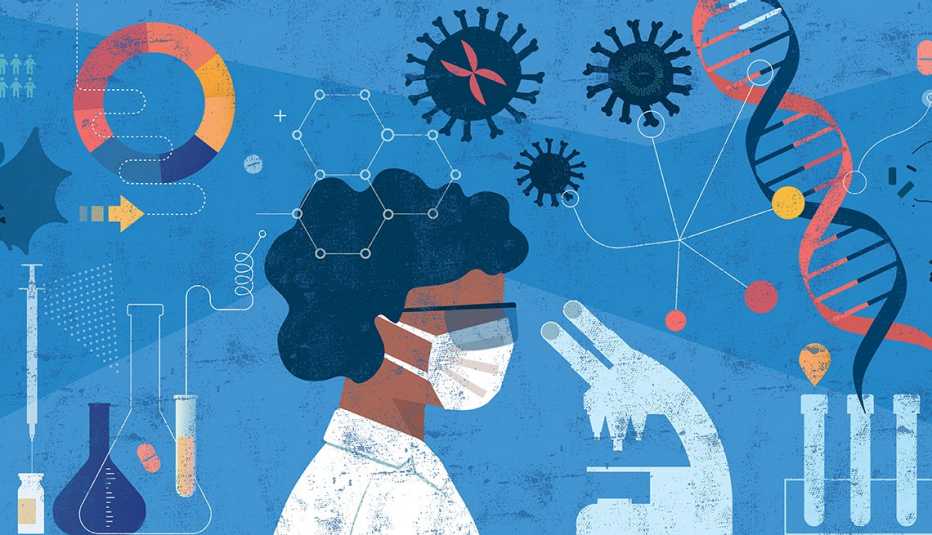New HV.1 COVID Variant Sweeps U.S.
This ‘great-grandchild’ of omicron is behind more than a quarter of coronavirus infections
By
Rachel Nania,
AARP
Published November 07, 2023
/ Updated November 21, 2023

GETTY IMAGES
Just in time for respiratory virus season, health officials are tracking a new coronavirus variant that has unseated its predecessors and is now the dominant strain in the U.S.
HV.1, as it’s known, currently accounts for about 29 percent of coronavirus infections in the country, the latest data from the Centers for Disease Control and Prevention shows. Just behind it is EG.5, also called Eris, which is responsible for about 22 percent of COVID cases.
Here’s what we know so far about HV.1, including how well experts expect our vaccines and treatments to work against it.HV.1 is in the omicron family
Similar to EG.5, HV.1 is a descendant of the omicron variant, which has been dominating in the U.S. since late 2021. Some experts are even referring to HV.1 and EG.5 as the great-grandchildren of omicron, says Matthew Binnicker, director of clinical virology at Mayo Clinic.
They share similarities with the original strain of omicron but have a few differences, or mutations, that set them apart, “and most of those mutations are rendering the virus, including HV.1, to be able to spread more efficiently from person to person,” Binnicker says.
Vaccines, treatments expected to still work
Despite this advantage, health experts expect our vaccines and treatments to remain effective against severe infections caused by the newly dominant variant. The reason: HV.1 is similar enough to another omicron spin-off, XBB.1.5, which is what the new vaccines target.
“There have been laboratory studies that have shown that the immune response generated by the updated vaccines are able to neutralize some of the more recent COVID variants,” Binnicker says.
Similarly, there’s no indication that antiviral treatments, like Paxlovid, will be rendered ineffective against HV.1, Binnicker adds.
That’s good news as we enter the time of year when the spread of respiratory viruses, including COVID-19, kicks into high gear. Cameron Wolfe, M.D., an infectious disease specialist at Duke Health, said during a September news briefing that we typically see a larger spike of COVID-19 in January and February, especially. “And I don’t see any reason that won’t be the case [again],” he said.
Currently, COVID-19 hospitalization rates are inching up; more than 16,200 Americans are being hospitalized each week with COVID-19, federal data shows. Deaths from the virus are also increasing. The CDC reports rates for the week ending Nov. 11 were up 9 percent from the previous week.
How to protect yourself from HV.1, other COVID variantsThe best way to protect yourself from winding up in the hospital with COVID — or worse, dying from the disease — is to get vaccinated, Binnicker and other health experts say. Vaccine uptake, however, has been low since the new vaccines became available in mid-September. As of mid-October, 7 percent of Americans in a national survey reported getting the shot.
Find COVID-19 Vaccines in Your State
AARP's 53 state and territory COVID-19 vaccine guides can help you find vaccines near you and provide the latest answers to common questions about costs, eligibility and availability.
“And that’s just not high enough,” Binnicker says. “We need to have a higher percentage vaccinated because we are seeing patients with COVID end up in the hospital and on ventilators.”
Older adults have been more likely to get the new vaccine than younger age groups. Data from the national survey, reported by the CDC, show that 15.4 percent of adults ages 65 to 74 received the new COVID vaccine as of mid-October; that share jumps to 20.5 percent when looking at adults 75 and older.
In addition to staying up to date with the vaccine, Binnicker says people who want to lower their risk of getting COVID-19 can wear a mask when they’re out in crowded public spaces, such as the grocery store. A good fitting, high-quality mask can help to block transmission of the virus. Also: Wash your hands often. “That’s really important to help prevent spread as well,” Binnicker says.
Having symptoms? Test yourself. (As of Nov. 20, the federal government is once again allowing U.S. households to order four free COVID-19 tests.) If you test positive, you may be eligible for a prescription treatment that can help stave off coronavirus complications — and time is of the essence with these medications. They work best when started within five days of the start of symptoms.
If your test is negative, try again in a few days. Binnicker says because many people have built up immunity from vaccination or previous infections, it can take longer for the virus to build up to detectable levels in the respiratory tract.
Rachel Nania writes about health care and health policy for AARP. Previously she was a reporter and editor for WTOP Radio in Washington, D.C. A recipient of a Gracie Award and a regional Edward R. Murrow Award, she also participated in a dementia fellowship with the National Press Foundation
Above is from: https://www.aarp.org/health/conditions-treatments/info-2023/new-covid-variant-hv-1.html
No comments:
Post a Comment